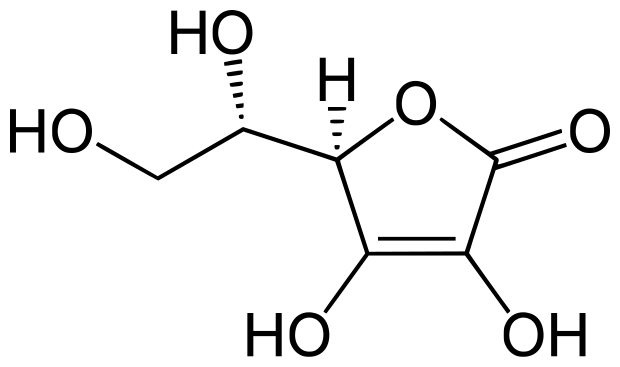Vitamin A vs Vitamin C
Vitamin A | Vitamin C | |
Common Name | Retinol derivative | Ascorbic acid and L-ascorbic acid, |
| |  | |
Deficiency diseases | Necessary for both low-light (scotopic vision) and color vision. | scurvy |
| The role of vitamin A in the visual cycle is specifically related to the retinal form. Within the eye, 11-cis-retinal is bound to the protein "opsin" to form rhodopsin in rods and iodopsin (cones) at conserved lysine residues. As light enters the eye, the 11-cis-retinal is isomerized to the all-"trans" form. The all-"trans" retinal dissociates from the opsin in a series of steps called photo-bleaching. This isomerization induces a nervous signal along the optic nerve to the visual center of the brain. After separating from opsin, the all-"trans"-retinal is recycled and converted back to the 11-"cis"-retinal form by a series of enzymatic reactions. In addition, some of the all-"trans" retinal may be converted to all-"trans" retinol form and then transported with an interphotoreceptor retinol-binding protein (IRBP) to the pigment epithelial cells. Further esterification into all-"trans" retinyl esters allow for storage of all-trans-retinol within the pigment epithelial cells to be reused when needed. The final stage is conversion of 11-cis-retinal will rebind to opsin to reform rhodopsin (visual purple) in the retina. Rhodopsin is needed to see in low light (contrast) as well as for night vision. Kühne showed that rhodopsin in the retina is only regenerated when the retina is attached to retinal pigmented epithelium, which provides retinal. It is for this reason that a deficiency in vitamin A will inhibit the reformation of rhodopsin and lead to one of the first symptoms, night blindness. | Scurvy is a disease resulting from a deficiency of vitamin C, since without this vitamin, collagen made by the body is too unstable to perform its function. Scurvy leads to the formation of brown spots on the skin, spongy gums, and bleeding from all mucous membranes. The spots are most abundant on the thighs and legs, and a person with the ailment looks pale, feels depressed, and is partially immobilized. In advanced scurvy there are open, suppurating wounds and loss of teeth and, eventually, death. The human body can store only a certain amount of vitamin C,[21] and so the body stores are depleted if fresh supplies are not consumed. The time frame for onset of symptoms of scurvy in unstressed adults on a completely vitamin C free diet, however, may range from one month to more than six months, depending on previous loading of vitamin C. Notable human dietary studies of experimentally induced scurvy have been conducted on conscientious objectors during World War II in Britain and on Iowa state prisoners in the late 1960s to the 1980s. These studies both found that all obvious symptoms of scurvy previously induced by an experimental scorbutic diet with extremely low vitamin C content could be completely reversed by additional vitamin C supplementation of only 10 mg a day. In these experiments, there was no clinical difference noted between men given 70 mg vitamin C per day (which produced a blood level of vitamin C of about 0.55 mg/dl, about 1/3 of tissue saturation levels) and those given 10 mg per day. Men in the prison study developed the first signs of scurvy about four weeks after starting the vitamin C-free diet, whereas in the British study, six to eight months were required, possibly due to the pre-loading of this group with a 70 mg/day supplement for six weeks before the scorbutic diet was fed. Men in both studies on a diet devoid, or nearly devoid, of vitamin C had blood levels of vitamin C too low to be accurately measured when they developed signs of scurvy and, in the Iowa study, at this time were estimated (by labeled vitamin C dilution) to have a body pool of less than 300 mg, with daily turnover of only 2.5 mg/day, implying an instantaneous half-life of 83 days by this time (elimination constant of 4 months). | |
Source | 1. Beef Liver — 713% DV per serving 2. Lamb Liver — 236% DV per serving 3. Liver Sausage — 166% DV per serving 4. Cod Liver Oil — 150% DV per serving 5. King Mackerel — 43% DV per serving 6. Salmon — 25% DV per serving 7. Bluefin Tuna — 24% DV per serving 8. Goose Liver Pâté — 14% DV per serving 9. Goat Cheese — 13% DV per serving 10. Butter — 11% DV per serving 11. Limburger Cheese — 11% DV per serving 12. Cheddar — 10% DV per serving 13. Camembert — 10% DV per serving 14. Roquefort Cheese — 9% DV per serving 15. Hard-Boiled Egg — 8% DV per serving 16. Trout — 8% DV per serving 17. Blue Cheese — 6% DV per serving 18. Cream Cheese — 5% DV per serving 19. Caviar — 5% DV per serving 20. Feta Cheese — 4% DV per serving |
|
References | Wolf G (June 2001). "The discovery of the visual function of vitamin A". The Journal of Nutrition. 131 (6): 1647–50. doi:10.1093/jn/131.6.1647. PMID 11385047. "Vitamin A". Office of Dietary Supplements, US National Institutes of Health. 31 August 2016. Combs GF (2008). The Vitamins: Fundamental Aspects in Nutrition and Health (3rd ed.). Burlington: Elsevier Academic Press. ISBN 978-0-12-183493-7. McGuire M, Beerman KA (2007). Nutritional sciences: from fundamentals to food. Belmont, CA: Thomson/Wadsworth. ISBN 978-0-534-53717-3. | https://www.drugs.com/monograph/ascorbic-acid.html Dietary Reference Intakes for Vitamin C, Vitamin E, Selenium, and Carotenoids. Washington, DC: The National Academies Press. 2000. pp. 95–185. ISBN 978-0-309-06935-9. Archived from the original on September 2, 2017. "Vitamin C". Micronutrient Information Center, Linus Pauling Institute, Oregon State University, Corvallis, OR. January 14, 2014. Retrieved March 22, 2017. |
Last modified: Thursday, 2 May 2019, 9:39 AM